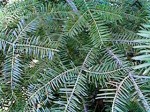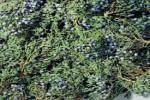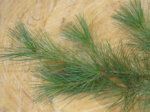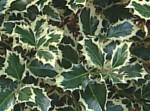 I always look forward to filling my house with fresh greens for the holidays. I love both their look and aroma and use them in arrangements alone or combined with fruit, flowers, cones, ribbons, artificial birds, and/or other Christmas ornaments. There are a large number of different kinds of greens available; some can be picked from the garden or woodlots, others are only available through florists. Some greens are quite inexpensive others are very pricey. Greens also vary in the length of their vase life so some can be used early in the season while others should be used just before a big event. All greens will benefit from a constant water supply so wreaths, garlands, and other decorations that have none should be treated with an anti-desiccant such as wilt pruf.
I always look forward to filling my house with fresh greens for the holidays. I love both their look and aroma and use them in arrangements alone or combined with fruit, flowers, cones, ribbons, artificial birds, and/or other Christmas ornaments. There are a large number of different kinds of greens available; some can be picked from the garden or woodlots, others are only available through florists. Some greens are quite inexpensive others are very pricey. Greens also vary in the length of their vase life so some can be used early in the season while others should be used just before a big event. All greens will benefit from a constant water supply so wreaths, garlands, and other decorations that have none should be treated with an anti-desiccant such as wilt pruf.
 Noble fir is one of the most beautiful greens and one that is commonly used by florists in centerpieces and wreaths. It has short, stiff, bluish green, curved needles that are densely packed on the on the stems and it adds a unique color and texture to an arrangement. It is expensive but has a vase life of up to 28 days.
Noble fir is one of the most beautiful greens and one that is commonly used by florists in centerpieces and wreaths. It has short, stiff, bluish green, curved needles that are densely packed on the on the stems and it adds a unique color and texture to an arrangement. It is expensive but has a vase life of up to 28 days.
 Its cousin, Balsam fir, has dark green rounded needles and a vase life about 20 days but is very inexpensive and more widely available
Its cousin, Balsam fir, has dark green rounded needles and a vase life about 20 days but is very inexpensive and more widely available
 Incense cedar is another premium green that is pricey but very pretty with its golden buds and lacy foliage. The branches are flat and soft and look fabulous as an accent in any arrangement. You don’t need a lot of this one to add a distinctive element to a centerpiece but, alas, it has a vase life of only 9 days.
Incense cedar is another premium green that is pricey but very pretty with its golden buds and lacy foliage. The branches are flat and soft and look fabulous as an accent in any arrangement. You don’t need a lot of this one to add a distinctive element to a centerpiece but, alas, it has a vase life of only 9 days.
 Another holiday green that adds texture and something special is berried juniper. The berries are a powdery, blue gray; the foliage is stiff and the branches tightly clustered. With a vase life of 37 days you can count on it for the entire holiday season. It is mid priced.
Another holiday green that adds texture and something special is berried juniper. The berries are a powdery, blue gray; the foliage is stiff and the branches tightly clustered. With a vase life of 37 days you can count on it for the entire holiday season. It is mid priced.
 White pine is a “must-have” in my arrangements and can usually be found in woodlots or bought cheaply. It has bluish green needles that are soft and slender, and are borne on curved stems that are ideal for creating softness in an arrangement. This is my favorite filler and I use it in every arrangement.
White pine is a “must-have” in my arrangements and can usually be found in woodlots or bought cheaply. It has bluish green needles that are soft and slender, and are borne on curved stems that are ideal for creating softness in an arrangement. This is my favorite filler and I use it in every arrangement.
 To add a totally different texture, try some of the broad-leaved evergreens such as holly and boxwood. Some varieties of holly have the advantage of bright red berries if you can snip their branches before the birds get them. Variegated holly is especially beautiful, adding white or yellow to the arrangement; I prefer the kind with solid white edges but all of them add impact to an arrangement. Both green and variegated holly have a vase life of only 6 days so should be used in short term arrangements. Hopefully, you have your own holly bushes, otherwise you will pay a hefty price for a small supply.
To add a totally different texture, try some of the broad-leaved evergreens such as holly and boxwood. Some varieties of holly have the advantage of bright red berries if you can snip their branches before the birds get them. Variegated holly is especially beautiful, adding white or yellow to the arrangement; I prefer the kind with solid white edges but all of them add impact to an arrangement. Both green and variegated holly have a vase life of only 6 days so should be used in short term arrangements. Hopefully, you have your own holly bushes, otherwise you will pay a hefty price for a small supply.
 Boxwood is another evergreen that adds a beautiful texture to an arrangement and is especially good in small arrangements where its small leaves and dark green color can be appreciated up close. If you grow boxwood you can remove a substantial number of stems from different places in the bush without damaging it. The vase life of English boxwood is 27 days so although the stems are expensive, it will last a long time and even looks good without water for a week or so (but keep it out of the sun if it does not have a water supply). Some people object to the smell but with all the other greens I use, it doesn’t bother me.
Boxwood is another evergreen that adds a beautiful texture to an arrangement and is especially good in small arrangements where its small leaves and dark green color can be appreciated up close. If you grow boxwood you can remove a substantial number of stems from different places in the bush without damaging it. The vase life of English boxwood is 27 days so although the stems are expensive, it will last a long time and even looks good without water for a week or so (but keep it out of the sun if it does not have a water supply). Some people object to the smell but with all the other greens I use, it doesn’t bother me.
When purchasing greens look for branches that are firm and full of green needles. Beware of signs of drying out, including browning, yellowing or fading color, and shedding needles. Conifers vary in their ability to retain needles; avoid hemlock and spruce as they are prone to shedding. Keep the greens in buckets at temperatures below 40 F in a draft free shady place until ready to use; outdoors is fine. Only the holly needs protection against freezing so it might be better stored indoors.
